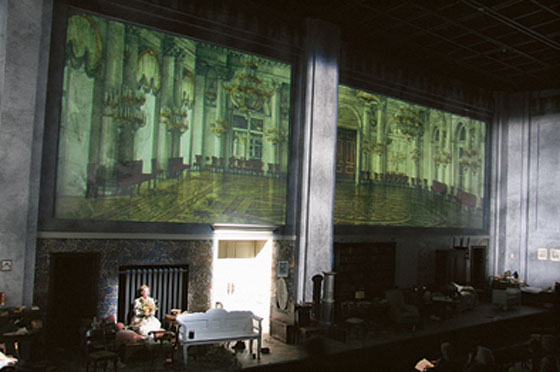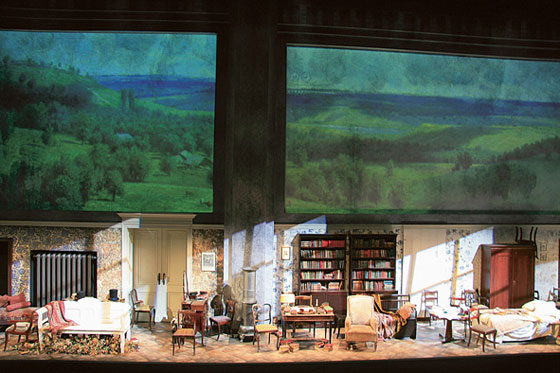|
|
| Eugene Onegin. A commentary Margarita Zieda, Art Critic | |
| The production of ‘Eugen Onegin’, created by director Alvis Hermanis and scenographer Andris Freibergs for the Schaubühne am Lehniner Platz Theatre in Berlin, has split German-speaking critics into the enchanted and the bored. Meanwhile, summarising opinions, the nachtkritik.de theatre portal wrote: “To us, this evening seemed inspiring to the highest degree.” Over the last two years, whilst creating productions in Cologne, Vienna, and Berlin, Alvis Hermanis has taken a profound interest in the 19th century person: about the feelings, thoughts, behaviour and material culture which enclosed the people of the time and influenced their actions. It is an attempt to understand – what was taking place in minds of the people of the time? In theatre, Hermanis works with whatever interests him, without being slave to what may be considered the modern path in contemporary theatre. Without undue stress or any inferiority complexes he continues to work in areas which are today considered old-fashioned, like costume drama, for example, and seeks to find new approaches and pathways within them. His latest work ‘Eugen Onegin’, however, links up in quite a peculiar way with the very latest phenomena in contemporary theatre and in cinema art – that is, with a powerful dose of authenticity. In the work of other contemporary artists authenticity is achieved by actors playing as near as possible to natural human behaviour, or by not using actors at all and directing non-professionals in a work, people who themselves and their lives represent the relevant theme. Alvis Hermanis’ actors, though, remain in distinctly artistic territory without even attempting to imitate anything, without pretending to be something they’re not. And the discussion isn’t about the authenticity of the people of today, but of a completely different century. It’s the sum total of all the theatrical elements, formed by the stage characters’ existence, the material culture surrounding them, poetry texts and cultural-historical comments about an era, allowing the universe of thinking from a different time to gradually build up inside the viewer’s mind. Without concealing its nature as art, but making use of its instruments to the fullest degree, the theatre in this production by Hermanis transforms into a “time machine”, creating a bridge which allows one to “zoom” into the consciousness of a person from a different century. | |
 Director Alvis Hermanis and stage designer Andris Freibergs. 2011 | |
| In the theatre and using the tools of the theatre, the production ‘Eugen Onegin’ presents a reconstruction of the 19th century, and this is achieved in a very brief period: an evening of theatre lasting an hour and forty minutes. Theatre research at the Schaubühne in Berlin In most recent theatre history – if we may assume this to be the theatre that has developed in Europe after the Second World War – it is Berlin’s Schaubühne specifically which has been extensively involved in a thorough research of different eras. Truly, as Austrian theatre critic Irene Bazinger pertinently points out: “Theatre is more ephemeral than other art forms, and maybe that’s why theatre people’s memories are often not very long (although there are exceptions). This is a pity, as with the passing of perhaps even one generation, what was done once and achieved sinks into oblivion, without being able to maintain and develop tradition further.” Alvis Hermanis’ production ‘Eugen Onegin’ continues to develop further the earlier Schaubühne theatre research – independently of whether this was or wasn’t actually his intention. In the 1970s, when director Peter Stein was in charge at the Schaubühne, he and his commune of actors tried to obtain a deeper understanding of theatre than was usual in repertory theatre practices. Through rigorous research of the foundations of contemporary theatre, it came to be regarded that the theatre of antiquity, Shakespearean theatre and Chekhov’s theatre were its fundamental mainstays. And it was through Stein’s research into Shakespearean theatre that there developed a desire to gain a real understanding of a person from Shakespeare’s time, to get into that person’s mind. The research undertaken by the director and his actors resulted in a gigantic production – the theatrical event ‘Shakespeare´s Memory’, which continued over two consecutive evenings and, due to its size, couldn’t be accommodated in the theatre: the CCC film studio’s pavilions on the outskirts of Berlin had to be hired for the performance. The idea behind ‘Shakespeare´s Memory’ was to create a living museum which would collate within it not just things that are clear to the perception of the modern person, but the foreign, complex and incomprehen-sible as well. ‘Shakespeare´s Memory’ opened at the very end of 1976, two days before Christmas, inviting the audience to enter a planetarium, the Cabinet of Utopia, the Garden of Compassion, the Lawn of Melancholy, the Theatre of Leonardo and the bowels of a ship, to partake of meals from other eras at a common table and to encounter the world of thinking and human behaviour from another era. Bit by bit, Peter Stein and his ensemble uncovered for the 20th century viewer another era – the theatre, natural sciences, philosophy, astrology, political theory and practices of the Elizabethan age. And the main thing that Stein and his actors wanted to understand was – who was that person, what was the consciousness of the viewer for whom Shakespeare wrote his plays? | |
 View from performance in the Schaubühne am Lehniner Platz Theatre in Berlin. 2011 Publicity photo | |
| Alvis Hermanis’ ‘Eugen Onegin’ continues this reconstruction of the consciousness of a person from a different century, however not through many isolated fragments, but rather through the reading of one single work, and for this selecting a powerful story about emotions – Alexander Pushkin’s novel in verse, ‘Eugene Onegin’. An encyclopaedia of Russian life The Russian critic Vissarion Belinsky once in a flash of inspiration called ‘Eugene Onegin’ “an encyclopaedia of Russian life ”, and it is on the encyclopaedic quality of the literary work that Hermanis has specially focussed his attention. He tells Pushkin’s tale about unrequited emotions, combining it with the comments of semiotician Juri Lotman as well as a number of other researchers of culture and history. Moreover, the commentary isn’t a foreign body in the flesh of Pushkin’s poetry. The author himself, while developing his novel in verse, interrupted the action from time to time, unable to desist from commenting, both with regard to his attitude to the characters and events he himself was creating as well as concerning the culture of the era. In this way we find out from Pushkin himself that Tatyana, feverish with love, doesn’t use Russian when composing the letter to Eugene Onegin, as she doesn’t have a sufficient command of the language to write on such an important matter, and instead she, a girl in the Russian countryside, writes it in French. Alvis Hermanis has enhanced and developed this same story-telling principle used by Pushkin – with digressions and comments, both on a textual level as well as in the materiality surrounding the people on stage – in the space, in the objects used and in the costumes, and in addition through a particular poetic dimension: works of art which are projected on the walls of the “room” of the performance. By choosing Andris Freibergs – “our theatre aristocrat”, Alvis Hermanis calls him – as the set designer for the production, a choice has been made in favour of refinement of the visual world. Not for satire, nor irony, which is evident in the author’s intonation and which quite legitimately would allow characterizations to develop that could even be rather grotesque, and ruthless. But neither is irony present at every level in Pushkin’s text either. In the places where the author touches upon genuine, true feelings, for the characters of which he is fond, he gives way to the force of poetic expressiveness without mockery. It was this level of the novel which was so important to Peter Tchaikovsky, transforming ‘Eugene Onegin’ into an opera of intense emotion. And the unsmiling level is important in this production as well – as the balance of depth to a surfeit of curious information and odd events. The thirty metre wide stage has been brought as close as possible to the eyes and sensory organs of the viewers; it has almost no depth at all and the entire range of objects of the material world can be examined even before any persons have entered into it. Creating the feeling inspired by the director, that “you’ve entered the room of someone from the 19th century”, Andris Freibergs has constructed rooms for four artistic characters: for the sisters Tatyana and Olga Larina, the friends Eugene Onegin and Vladimir Lensky, and one for the author himself – Alexander Pushkin. The rooms merge from one to the next, without clearly defined divisions, joining up into a common living space. A portrait of the poet hangs unobtrusively on the wall, and during the performance it is bathed in light. There are beds – adult beds, a child’s bed, beds with ornate chamber pots under them; office chairs, little vanity tables with chairs, small garden benches and bookshelves, and a huge radiator, almost the size of the bookshelves, which hadn’t really even been invented at the time the novel was written and became a domestic fixture, together with heating, largely in the late 19th century. A kind of stumbling-block in the totality, one that almost imperceptibly intensifies the attention. Freibergs’ interior also includes Pushkin’s desk and chairs, which will be noticed by those in the know. Doors, doors and more doors. Doors closed, each behind themselves. Dried out flowers by the garden bench, into which emotionally wounded people will pour their feelings. The world of Andris Freibergs is poetic. And there is no ugliness therein. A story about feelings In Alvis Hermanis’ version of the text, the story about feelings begins with some bare facts about the life of the author of ‘Eugene Onegin’ and his own emotional experiences. “113. 113 women. Pushkin had loved 113 women before he proposed to the woman who later became his wife. And he listed down these 113 women in a long register... Natalya I, Catherine I, Catherine II, Princess Avdotya, Nastasha, Catherine III, Aglaé, Calipso, Pulcheria, Amalia, Eliza, Yevpraksiya, Catherine IV, Anna, Natalya...” The voice of the actor sounds light and gentle, and with the same lightness we move on to the St. Petersburg of 1820. Snow. Snow on marble statues majestically rising in the dark, on snow-covered rooftops, on frozen canals, on sleds that dash across the bridges at great speed and stop at the theatre. On the beauty of the icy night, the theatre windows flooded with light, on the doors which open... And then, together with Onegin, the viewer is brought to a sort of reality, the atmospheric power of which, when described, almost transforms into a world worthy of the pen of Edgar Allan Poe. “Fusty air rolled over them, immediately causing their foreheads to break out into perspiration. 2,000 all too rarely washed bodies emanated quite a considerable stench... Stale sweat and grime had not been cleaned out from clothing for months. Bared lips revealed black teeth, thickly applied salve keeping them healthy... Bored, Onegin put on his glasses and looked over the ladies in the theatre boxes. That was fairly provocative. You don’t look over other people with glasses. And as for ladies, certainly not!” | |
 View from performance in the Schaubühne am Lehniner Platz Theatre in Berlin. 2011 Publicity photo | |
| It is in this kind of combination – poetic beauty and the occasionally completely shocking exposure of reality – that the world of ‘Eugene Onegin’ begins to unfold and develop. It is poetry that has prose intruding on it constantly, the prose of life. It is striking and surprising, and convincingly takes over the space of the story, with poetry allowed to enter for the most part where there is a place for feelings. Occasionally suppressing feelings as well, so that, God forbid, wallowing emotionality is avoided, both on the stage as well as in the auditorium. Thus one of the most emotional points in the novel, where Onegin takes revenge on his friend by trampling all over his feelings because he’s had to spend the evening in the company of simple country people, a momentary impulse that develops to the tragedy of a pointless duel, is almost completely overlaid by a commentary thick with anecdotes. About the practice of duelling, its regulations and derivations – in France, women once fought duels with swords and bared breasts; about Pushkin’s duelling experience – the poet had duelled twenty nine times, the last such encounter causing his death. Once he’d arrived at a duel drunk, eating cherries from his top hat which was full of them. His bemused opponent declined to duel with the words that Pushkin, still eating breakfast, was not yet ready to die. In the room of the performance, too, there are jars of pre-served cherries on one of the little tables. From one of the jars Lensky is eating cherries, without having removed his white gloves. The cherry juice trickles down his cheeks, down his neck – like the texts saturated with amusing information which flow through the space, although the subject of them is, in actual fact, death. The tragedy in this production is silent. It takes place within the people and externally is almost imperceptible. It is only in the concluding part of the story that the space is almost completely taken over by poetry. This is when Onegin, after three years spent wandering abroad, meets the once rejected Tatyana in St. Petersburg and falls wildly in love with her, but she rebuffs him. With a laconic prose insertion: “As a married woman, Tatyana could have succumbed to Onegin and become his mistress. In the highest ranks of the aristocracy this was tolerated, even quite commonplace.” But this possibility is swept away into oblivion by the poetry. Without flaring up into excessive emotion, but concluding in cheerful manner – leaving Tatyana’s spurned Onegin in confrontation with her husband, and the author ending his tale with a triple hurrah. Sensuality, viewpoint, costume By dampening down the emotionality, Alvis Hermanis brings to life the 19th century, in his reconstructive work expanding on theatre’s sensual nature with full force. Contemporary German writer Patrick Susskind, in his novel ‘Perfume’, was also able to take his contemporaries into a different era – to 18th century France – convincingly, almost to the point of nausea, through all sorts of odours and smells. Hermanis doesn’t remain stranded in these darker layers, which open up a bottomless pit for the imagination. The director instead turns the most beautiful side of theatre’s sensual nature to the viewer – through the gentle, quiet and light intonation of the production, at no time with raised voices, let alone shouting – which is completely uncharacteristic of contemporary European theatre, and through the images projected on the walls of the room that provide a visual commentary on the 19th century. At that time photography had not yet been invented, and all the witnesses to the era come via works of art. The masters of the works may be greater or lesser, but that’s not important. It’s not just the material culture of the time which is captured in the reproductions of works by Repin, Kustodiev and Shishkin, but also a 19th century viewpoint of people, objects, life situations – such as duelling to the death, or eating watermelon. It is the atmosphere evocative of the 19th century that enters. Authenticity is delivered by artist Eva Dessecker’s painstakingly finished costumes, accurate to the smallest detail, in which the beauty of the female apparel alternates with the slightly comic male costumes. The men’s attire is short on elegance, but this is not due to any strange ideas on the part of the artist. The lack of elegance has come about through the director taking a special interest in reality, in everything that is to be found behind the veneer. And in taking an interest as to why men, who in the 21st century need less time than women to prepare for a ball, needed three hours of preparation in front of a mirror in the 19th century. The actors, on entering a 19th century room in contemporary clothing and starting up the story about a different era, begin to become these people. And this takes place by slowly changing their clothes. Putting over their bodies all of these constructions which were contrived in another century. The 19th century person begins with different underwear and finishes with hair stuck down over the forehead. In the work of Alvis Hermanis, his creative team and the Schaubühne actors, the 19th century is illuminated through a detailed and sensitive reconstruction of reality, without human psychologization and with a gentle lightness that is unusual in contemporary theatre. Like memories that are beautiful, and ones that people can remember together. /Translator into English: Uldis Brūns/ | |
| go back | |







